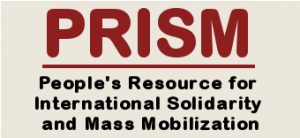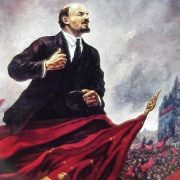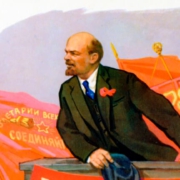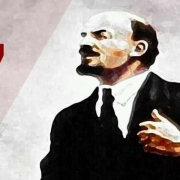The Young Lenin
Editor’s note: This article on the childhood, youth, and earliest revolutionary activism of V.I. Lenin draws heavily from Vladimir Ilyich Lenin: A Biography, a voluminous work by several Soviet authors with P.N. Pospelov as editor, and published in 1965 by Progress Publishers. It also draws from other biographical sources as well as from the History of the Communist Party of the Soviet Union (Bolsheviks): Short Course. We hope to follow up with subsequent articles on the subsequent historic phases of Lenin’s life and work.
The Young Lenin
Childhood, youth, and early revolutionary activism
Vladimir Ilyich Ulyanov was born on 22 April 1870 (10 April in the old Julian calendar), in Simbirsk, a small town of 30,000 on the banks of the great Volga river. When Vladimir became a revolutionary, he assumed various pen names, but eventually he would be known in history and the people of the world as Lenin (“man of Lena”), from the name of a town near his place of Siberian exile.
Family and school upbringing
Vladimir’s parents were commoner-intellectuals, although they enjoyed a somewhat high social standing. His father, Ilya Nikolayevich, had lower middle-class origins and was a devout Russian Orthodox. Through hard work and sheer ability, Ilya took his degree at the University of Kazan and became a high-school science teacher. In 1869, he became an inspector and later director of elementary schools in Simbirsk province. He went on regular tours of the province, spending weeks and months travelling through villages to help teachers set up schools for peasants’ children. He had a large following of progressive-minded teachers known as “Ulyanovites.” For his almost 20 years of meritorious service, he received a low rank of nobility. But, unaffected by bureaucracy, he remained a democrat who easily mixed with rural village folk.
Lenin’s mother, Maria Alexandrovna, was the daughter of a medical doctor. By inheritance, the family came to own a small rural estate in Kokushkino near Kazan. Born and bred in a rural setting, Maria was educated at home but later, through self-study, passed the exams for elementary school teacher. While also drawn to educational work, the responsibility of keeping a big household took up most of her time. She mastered several foreign languages and taught these to her children. She read a lot and played the piano very well. A Lutheran by upbringing, she was indifferent to church ceremonies. All these traits influenced the entire family.
The Ulyanov family were a close-knit family. The parents gave their six children (Anna, Alexander, Vladimir, Olga, Dmitry and Maria) an all-round education, encouraging in them a capacity for self-study and a taste for exploration. They directed their children’s reading, subscribed to magazines for them, often gathered them for book reads and story-telling, and supported a home journal that they themselves kept.
Ilya set himself as a personal example in cultivating among the children the values of hard work, honesty, modesty, thirst for knowledge, sympathy for other people, and a high sense of social responsibility. Maria Alexandrovna’s cheerful temper, moral courage, self-discipline, methodical habits and neatness were absorbed by the children. In return, they respected and loved their parents.
The childhood of Volodya was a happy one. (Volodya, diminutive for Vladimir, was how his wife and closest relatives prefered to call him throughout life.) He was playful and competitive but hated fights. At the same time, he spent much time reading books. He grew up a healthy and jovial boy. From age 9 to 17, he attended the Simbirsk Gymnasium (similar to high school), where he put his self-discipline and inquisitiveness to good use. He became a top scholar, garnering honors from year to year even while helping with his classmates’ schoolwork. Others remember him during this time as a good swimmer, skater, and chess player. He also studied music but gave it up, to his later regret.
Shaping of Lenin’s revolutionary views
While Vladimir’s childhood was idyllic and ideal for his social class, the 1870s was a period of worsening hardship for the Russian people under harsh Tsarist rule. Independent thinking was frowned upon even in schools such as the Gymnasium he attended. His early outlook was shaped mostly by his family upbringing, the revolutionary-democratic literature available to him, and direct contacts with the people of the Volga region.
Highly observant and a good listener, Vladimir gradually saw the poverty, ignorance and tyranny around him. He soon broke with religion and turned to radical Russian writers. His growing awareness of class oppression was reflected even in his school essays. He was also greatly influenced by his elder brother Alexander, who was himself a strong-willed and extremely gifted youth. He looked up to his brother as an authority and model.
At that time, large numbers of intellectual youth were influenced by vague socialist ideas. Seeking to go among the narod (“the people” in an abstract sense), they donned peasant garb and flocked to the countryside. Known as Narodniks, first they tried to organize the peasants but achieved little. Some persisted in the effort to turn traditional peasant communes into “socialist” ones, while others turned instead to conspiratorial plots to overthrow the brutal Tsar.
Many Narodnik youth belonged to the revolutionary Zemlya i Volya (“Land and Freedom”), which later split into two. One wing formed the Chornyi Peredel (“Universal Partition”), from which some would later shift to Marxism such as G.V. Plekhanov, P.B, Axelrod and V.I. Zasulich. Another wing formed the terrorist group Narodnaya Volya (“People’s Will”). In 1881, members of this group succeeded in killing Tsar Alexander II with a bomb. His successor Alexander III carried out worse repression, executing many radicals and sending others to Siberian exile. Soon after, the majority of Narodniks renounced the revolutionary struggle and sought to reconcile with Tsarism. By the 1880s and 1890s the Narodniks began to serve as the voice of the kulaks (rich peasants).
Meanwhile, the illegal groups that persisted in revolution went deeper underground or into self-exile abroad and became more interested in Marxism. In 1883, the Emancipation of Labor group led by Plekhanov was set up in Switzerland. It translated Marx’s and Engels’ works into Russian, published other Marxist writings, and had them smuggled back to the homeland. It thus played a big role in systematically spreading Marxism, analyzing its application to Russia, and combatting Narodism. Study circles at the time avidly read and discussed Plekhanov’s writings and other Marxist literature. However, in the decade of 1884-94, these small and separate circles had not yet any practical connections with the workers’ mass movement.
Meanwhile, Lenin’s brother Alexander went on to study zoology and chemistry at the St. Petersburg University, where his academic excellence shone. On summer vacation at home, he spent all of his time on his thesis. Unknown however to his professors and even to his family, Alexander had already become a revolutionary activist at that time, influenced by both the Narodnaya Volya and Marxism. He was involved in secret student circles and engaged in propaganda among the St. Petersburg workers. It was in Alexander’s hands that Lenin first saw Marx’s Das Kapital.
Suddenly in January 1886, Ilya Ulyanov died of a stroke at age 54. One year later, on 1 March 1887, Alexander was arrested for his part in the Narodnaya Volya’s attempt to assassinate Tsar Alexander III. Their eldest sister Anna, also a St. Petersburg student, was arrested too. Simbirsk’s liberal-intellectual circles quickly distanced themselves from the Ulyanovs.
Their widowed mother attended the trial of Alexander and his comrades, where he spoke passionately against Tsarism and on the inevitable victory of socialism. On 8 May 1887, he was executed. While Vladimir was deeply affected by his brother’s heroism and death, it also made him reject the path of individual terrorism and seek another path which later led him to embrace Marxism and the working class.
Vladimir went on with his high-school studies. He was permitted to take his school’s final exams and brilliantly passed it, the sole recipient of a gold medal among the graduates. At first, the school authorities had second thoughts about giving the medal to the brother of a “state criminal;” but they had no choice. As the official Gymnasium endorsement stated: “Highly capable, hardworking and painstaking, Ulyanov was top scholar in all forms, and upon finishing school has been awarded a gold medal as the most deserving pupil in regard to progress, development and conduct.”
Revolutionary baptism
To evade social disrepute and a strict police ban, the remaining Ulyanovs left Simbirsk in end-June 1887 and stayed for two months in the family’s Kokushkino estate. Then they moved to nearby Kazan, where Lenin enrolled in the Imperial Kazan University’s college of law. Already resolved to become a revolutionary, he planned to dive into the social sciences by studying law. The university authorities balked in admitting him until his Gymnasium’s glowing endorsement (as quoted earlier) changed their mind. Before the year was through, however, Lenin would be involved in a student protest. He would confront state brutality once more, this time face-to-face.
Police spies lurked in all corners of Russian universities. Any student organization was banned, and membership in one was punishable by expulsion. Nevertheless, Lenin joined the Samara-Simbirsk Club, which operated as an illegal circle of revolution-minded students from the Volga region. On 4 December 1887, students gathered in the university assembly hall and demanded an end to police persecution, freedom for student associations, and reinstatement of expelled students. Lenin was in the front row and among the most active participants. He also formally asked the Rector to drop him from the roster of students, as an ultimate sign of protest.
Quickly marked as one of the ringleaders, Lenin was expelled from the university, arrested, and imprisoned together with other student protestors on 5 December. Two days later, he was banished from Kazan to his mother’s Kokushkino home. The provincial police chief was ordered to keep a “strict and secret watch” on him.
In this first experience of exile, Lenin set himself to systematically absorb a wide range of socio-political, economic, and statistical literature, and continued his law education through self-study. He read (in his own words) “voraciously from early morning till late at night.” Following a strict schedule, he studied the prescribed university courses, read newspapers, periodicals, and fiction (reading his favorite authors over and over), and wrote detailed summaries and notes. He was especially fond of Chernyshevsky’s materialist, revolutionary and socialist writings, including the novel What Is To Be Done? which was also his executed brother’s favorite book.
Joining a Marxist study circle in Kazan
After nearly a year of exile, Lenin was allowed to return to Kazan but was essentially blacklisted. He was not readmitted to the university because he was considered unreliable “… although he possesses outstanding abilities and is extremely well informed.” When Lenin asked permission to study abroad, he was again refused.
While seeking other ways to finish his formal studies towards a law degree, Lenin joined one of several illegal Marxist study groups in Kazan, where the works of Marx and Engels were studied and discussed, and their particular application to Russia debated. The particular study group he joined was organized by Nikolai Fedoseyev, one of the first revolutionaries in Russia to proclaim his adherence to Marxism. (The two never met in person due to clandestine conditions but later kept contact through letters.)
While making personal contacts through Kazan’s Marxist study circles, Lenin deepened his grasp of Marxist theory through the same systematic self-study methods as he did in Kokushkino. All the major works of Marx, who had died 15 years earlier, were already available to him together with the writings of Engels, Kautsky, and Russian socialists. He made a serious study of Marx’s Capital, especially on its applicability to socio-economic conditions and tasks of the workers’ movement in Russia. He became convinced that the Russian working class, young as it was, was destined to be a great revolutionary force if it developed socialist consciousness.
Like the other youthful Marxists, Lenin was drawn to the struggle against Narodism and thus compelled “to educate themselves, to read illegal literature of every trend…” At that time, Narodism (the politics of the old Narodniks) was popular among the revolutionary-minded intellectuals. The Narodniks claimed that capitalism’s taking root in Russia was just accidental, and the country’s path to socialism was through the peasant commune. The intellectuals also idolized the old Narodnik heroes who used tactics of individual terrorism as method of political struggle.
Contrary to Narodnik views, capitalism was developing belatedly but rapidly in Russia, partly fuelled up by an influx of foreign capital. Factories sprung up in St. Petersburg and other regions, and coal and iron mines as well. Railway lines began connecting the center with the border regions. The Russian proletariat was growing fast and gaining strength, their ranks swollen by landless peasants migrating to the cities. Spontaneous strikes broke out and proletarian organizations emerged. Workers became receptive to socialist ideas, which were spread among them by Social Democratic groups. (Many European socialist parties called themselves SD’s back then.)
Lenin’s Samara period
In early May 1889, the Ulyanovs left Kazan for Samara province, where Lenin earned a living by giving tutorials. Meantime, the tsarist police tracked down the Kazan study circles and in July arrested its members, including Fedoseyev and several others belonging to Lenin’s circle. Thus Lenin escaped a second arrest only by chance. But even in Samara he remained under police surveillance.
Unable to attend any university, Lenin repeatedly tried to get permission to take his law exams without attending lectures. In early 1890, he finally got permission to take the exams at the St. Petersburg University as an external student. He began to prepare, planning to master the 4-year university course through 18 months of self-study. He set up a “work room” in a far corner of the garden. There he would work on his books and notes from morning till nightfall. Being fond of music, his occasional relaxation was singing together with his sister Olga on the piano.
In 1891, Lenin took his two-stage exams in Law at the St. Petersburg University. He received the highest marks in all subjects and was granted a first-class law diploma. He took advantage of his long stay in the city to contact local Marxists and gather a good harvest of Marxist literature.
In end-January 1892, he was called to the bar and began to practice in the Samara circuit court as a barrister’s assistant. He appeared for the defence in court about 15 times throughout 1892-93. Behind his legal practice, however, he was already devoting most of his energies to active revolutionary work. Several illegal study-circles (mostly of students) operated in Samara, majority of which followed Narodism. Lenin came to know A. Sklyarenko, the leader of the most active circle, which produced illegal publications and propagandized among students and some worker contacts.
From there, Lenin expanded his contacts and Marxist advocacy among Samara’s study circles, and delivered lectures in critique of Narodism. As a result, many members of the main circle he joined, including Sklyarenko himself, broke with Narodism and shifted to Marxism. From this first wave of followers, Lenin organized the first Marxist circle in Samara in 1892. For use in his lectures, Lenin wrote several articles, translated Marx’s and Engels’ Communist Manifesto from German, and discussed other locally available Marxist works.
In terms of clandestine techniques, the illegal study circles would sometimes go on a “grand tour”—a long boat trip up and down the Volga lasting for several days and safe from police eyes. Such trips enabled them to focus on their theoretical and practical discussions, and were also an excellent way of relaxation and sightseeing. Lenin would later remember these “grand tours” he went on with the Samara comrades.
Among his growing ranks of followers, Lenin’s prestige stood tall. According to an old Samara comrade: “Simplicity, tactfulness, a zest for life were remarkably combined in this twenty-three-year-old man with dignity, profound knowledge, ruthless logical consistency, clear judgment and precision in definitions.”
Some Narodnik revolutionaries, veterans of the 1870s but mostly retired from politics, lived in Samara. Lenin, who deeply respected them despite the difference in views, spent long hours talking with them and listening to their stories about clandestine work and their conduct during interrogations and trials.
Using the Marxist scientific method, Lenin made a profound study of Russia’s economy. He collected and analyzed vast amounts of data on peasant farming, carefully studied rural life, and often had talks with peasants and other people familiar with agrarian conditions. He enlisted the help of Sklyarenko and other study-circle members. During his summer stays at the Alakayevka farm, he would often visit A. Preobrazhensky, who organized a Narodnik agricultural colony nearby. There he befriended peasants and listened to their stories. Preobrazhensky, urged by Lenin (who also helped his Narodnik friend draw up a census questionaire), made a rural survey of one of the villages. Lenin’s extensive and practical knowledge of Russian peasant realities were of great help in his subsequent theoretical researches .
Lenin first set forth his analyses and conclusions as a lecture to the study circle, then in his 1893 article “New Economic Developments in Peasant Life.” This was his earliest surviving theoretical article. Here he thoroughly analyzed rural conditions, citing data on the development of capitalism and growing class differentiation within the peasantry, and so smashed Narodnik myths about the immutability of peasant farming. The article’s contents would later be incorporated into his book The Development of Capitalism in Russia.
Growth beyond Samara
Lenin’s revolutionary activities reached beyond Samara to other towns in the Volga region—turning the region into an initial hub for the spread of Marxist ideas in Russia. Through his brother-in-law M. Yelizarov, he linked up with other revolutionary intellectuals. Through his efforts in study circles, he brought them over to Marxism. He also corresponded with Fedoseyev, his comrade from Kazan for whom he had deep affection and respect, who was still in prison.
Kazan and Samara were important landmarks in Lenin’s life and work, during which his Marxist convictions crystallized. In Samara, he gained a higher capacity to combine theory and practice and rich experience in building a political-organizational base. Nevertheless, he wanted to shift to a major industrial center with a numerous proletariat. With this aim, he left Samara for St. Petersburg in August 1893. #






Leave a Reply
Want to join the discussion?Feel free to contribute!